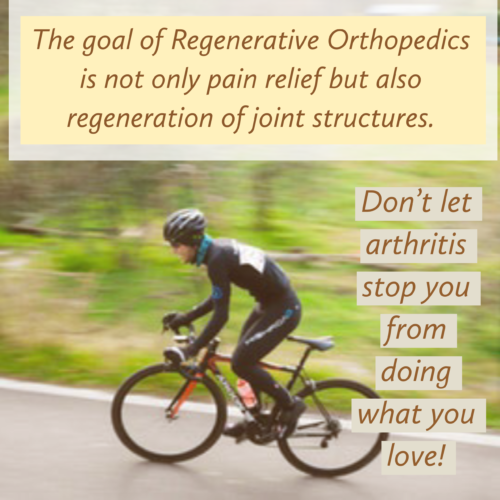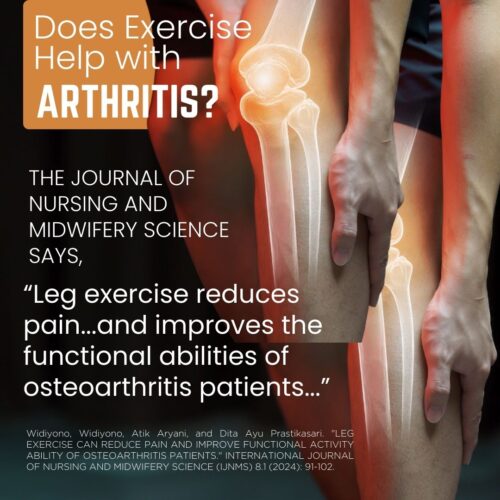
Older Athletes Can Keep Doing What They Love
Athletes want to maintain their level of exercise and activity over the years. Understandably so! Exercise is one of the most effective ways to improve and maintain health. Keeping active physically is correlated with lower risks of cardiovascular disease, lower blood pressure, weight reduction, and the provision of an increased sense of well-being. It’s no wonder that more and more people are becoming active in exercise programs and desire to maintain a level of physical activity throughout life. But is exercise associated with a higher risk of arthritis?
Athletes—and especially long-time athletes—may wonder if increased joint stress leads to premature “wearing out” of the joints and the development of arthritis.
Studies show that joint injury is the main factor increasing the arthritic risk in athletes. Exercise itself has a more protective role.
For example, having well-developed muscles decreases the loading on the cartilage and thus has a protective effect. Animal research also shows that exercise like running does not harm normal joints even under high loads and long distances. However, the same type of exercise done on an injured joint will lead to arthritic change.
Activities like bicycling and pool exercises maintain flexibility, strengthen the muscle, and boost coordination, protecting the cartilaginous surfaces because they help maintain joint function.
The Journal of Nursing and Midwifery says in cases of knee osteoarthritis, “leg exercise reduces pain and improves function”. (1)

Sports injuries and traumas accumulate over a person’s life and can damage ligaments and cartilage. It is not uncommon for athletes to injure joints. This injury, or the non-healing of it, causes the degenerative process to start in the joints.
The repetitive low-grade impact from athletic events can be enough to damage the soft tissues and start the arthritic process. Some studies do note an increased incidence of arthritis in particular sports due to their vigorous nature and their propensity to lead to trauma. For example, wrestlers, boxers, baseball pitchers, cyclists, gymnasts, ballet dancers, soccer players, weight lifters, and football players have all been reported to have degenerative joint disease due to sports-related stress. This degeneration occurs due to soft tissue injuries (non-healed injuries) that were not fully addressed.
The hope for older athletes is to be as fit as they were in the prime of their athletic careers. Often, however, this is not the case because of the degeneration caused by non-healed sports injuries. Sports injuries that lead to symptomatic arthritis later in life are generally those that occur to the ligaments. The ligament injury causes the joint to become unstable.
Typically, bone spurs develop in the ligaments/fascia (as in plantar fasciitis). These are generally signs that the ligaments can no longer stabilize the joint. The body responds by bringing in reinforcement through additional bone formation. This extra bone formation is called arthritis.
Athletes want to play sports for a lifetime. Unfortunately for many, the degenerative changes that occur due to non-healed old athletic injuries, combined with a decreased ability to heal and the natural degeneration that occurs with aging, make sporting injuries commonplace in the older athlete. A lifetime of microtraumas in ligaments and tendons over the years, along with weakening muscles and poor flexibility, can lead to a reoccurrence of these injuries.
What causes the mechanical and molecular events in arthritis to occur? Although cartilage lacks nerve fibers, could cartilage wear and tear be the origin of arthritis? An article published in Gerontology conducts a literary review to prove that arthritis starts with ligament damage. After reviewing numerous research articles, the authors conclude that subchondral bone changes (the bone just beneath cartilage) precede any cartilage change associated with arthritis. These bone changes are due to a loss of tension on the bone at the ligament/bone insertion.2
“The earliest change appears to be at the ligament-bone insertion site. We propose that a change in the ligament leads to an alteration in the tension on the bone at the bone-insertion site, which precipitates bone remodeling (injury to subchondral bone). The overlying articular cartilage’s health and integrity depend on its bony bed’s mechanical properties. Ligament injury precedes the subchondral bone changes, which occur before articular cartilage degeneration.”2
Taking into account the progression of arthritis, it becomes clear that ligament integrity or lack of integrity is what needs to be treated to prevent further joint destruction. In other words, ligament laxity causes bone changes that, in turn, cause cartilage change and damage. Ligament laxity is due to ligament damage.
When researchers attempt to stimulate arthritis or degeneration in a joint, they do so by damaging the ligaments around it. Wow! What happens then? Once the ligaments are damaged, the instability created increases the pressure in the joint where they were injured. The increased pressure accelerates the degenerative process. Eventually, the body stabilizes the segment by overgrowing bone. This overgrowth of bone is typically seen on X-rays as bone spurs, spondylosis, or fused joints.
Gerontology points out the need for therapeutic strategies to be redirected toward healing ligament damage, the initial cause of arthritis. Fortunately, Regenerative Orthopedics can do just this and repair the degenerated joint.
Standard arthritis treatments generally involve only symptom management rather than joint repair. They include NSAIDs, cortisone shots, and even surgery to provide pain relief.
The most common surgery is arthroscopy, which in numerous medical studies was found to be no more effective than placebo regarding arthritis.
Joint replacements are increasingly recommended, as demonstrated by the hundreds of thousands performed every year. However, these treatments are anti-healing and can cause further degeneration of arthritic joints. Once the surgery is done, it cannot be undone!
Regenerative Orthopedics are directed at the painful sites where ligaments and tendons connect to bone, and trigger points and adjacent joint spaces produce a healing response. Along with growth factor stimulation, this induces healing and strengthening of the damaged or diseased structure. The result is the repair of the damaged ligaments and soft tissue, allowing the aging athlete to continue with their desired activity and sport. Regenerative Orthopedics can reverse joint damage and alleviate arthritis pain. A number of case studies have shown the success of regenerative techniques in patients with diagnosed arthritis.3,4
In a study of almost 17,000 people examined from 1970-1995, high levels of physical activity were not associated with symptomatic arthritis in older men and women runners over age 50. Six other reviews on the effectiveness of high and low-intensity exercise on managing arthritis in the elderly found clinical outcomes of arthritis to be improved.5
According to scientific studies, exercise and recreational activities appear not to cause wear and tear on the joints. This can be seen in medical research over many years, supporting the findings that exercise is beneficial rather than harmful. The author of a systematic review of multiple medical databases said, “The first consideration with respect to exercise is whether ‘wear and tear’ resulting from repetitive use of articular cartilage is the primary driver for degenerative change. If this were the case, the exercise would lead to progressive arthritis. According to the evidence presented here, this does not seem to be the case.”6
In our opinion, Regenerative Orthopedics is the treatment of choice for treating joint pain in older athletes due to ligament and other soft tissue injuries. It is amazing how many athletes avoid surgery once they are treated with Regenerative Orthopedics because the treatment eliminates the pain, stabilizes the joint, and returns function.
Regenerative Orthopedics can significantly impact the rehabilitation of injured older athletes. Despite their age, only four or five sessions are typically needed for the athletes to achieve complete healing and return to their physical best. Injections involving the knees, shoulders, hips, ankles, elbows, and other joints can easily be performed, often with dramatic results and improvement.